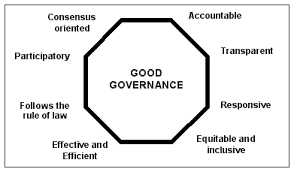
The concept of good governance holds universal recognition as a fundamental pillar of effective and just governance. It encompasses a set of principles that aim to ensure transparency, accountability, equity, and responsiveness in the administration of a nation. International organisations and scholars have emphasised the significance of good governance in fostering stable and prosperous societies.
However, its practical implementation and impact can vary significantly depending on the context. In this article, we will delve into a comparative analysis of different narratives of good governance, exploring two distinct scenes: the principles outlined by the United Nations and the realities of governance under the present Indian government. Additionally, we will draw parallels with the historical model of good governance during the Khilafat-e-Rashidah era, shedding light on its relevance in contemporary discussions.
UNO’s Definition of Good Governance: The United Nations outlines eight major characteristics of good governance, which serve as a comprehensive framework for evaluating governance practices worldwide.
- Responsive: Governance should prioritise the needs and interests of all stakeholders in a timely and effective manner.
- Accountable: Institutions, sectors, and organisations must be answerable to both the public and institutional stakeholders for their actions and decisions.
- Transparent: The functioning of the government should be open to public scrutiny, fostering trust and credibility among citizens.
- Effective and Efficient: Utilisation of resources should be optimised to maximise community welfare and development.
- Equity and Inclusiveness: Ensuring fairness and justice for all members of society, regardless of their social background or status.
- Consensus-oriented: Decision-making should seek common ground, promoting compromise and minimising harm to any group.
- Participatory: All segments of society, including marginalised groups, should have an opportunity to express their views and participate in governance.
- Rule of Law: Impartial enforcement of laws, including human rights, to prevent the dominance of the powerful over the weak.
CONTRASTING REALITIES: The present Indian government came to power in 2014 with promises of improved governance and economic growth. However, its governance has faced numerous challenges and shortcomings, which raise concerns about adhering to the principles of good governance:
- Lack of Transparency and Accountability: Instances like the sudden demonetisation policy in 2016 raised concerns about the government’s transparency and decision-making process, causing hardships for citizens. The government also implemented three agriculture laws without proper consultation, leading to fierce farmer protests for over a year, eventually prompting the government to announce the repeal of the laws.
- Economic Mismanagement and Policy Failures: Economic promises, such as achieving a USD 5 trillion economy, remain unfulfilled, and the country faces increasing debt and currency depreciation. The implementation of the Goods and Services Tax (GST) revealed issues with policy execution, negatively impacting small businesses and traders. The governance failures have hindered economic growth, resulting in job losses and widening socio-economic inequalities.
- Neglect of Social Issues and Human Rights Violations: The government’s handling of the migrant crisis during the COVID-19 lockdown exposed a lack of preparedness and sensitivity, while cases of human rights violations raised questions about its commitment to inclusivity and justice.
- Erosion of Democratic Values: Concerns over the rise in centralisation of power and suppression of dissent have led to questions about the health of India’s democracy. The Parliament’s functioning has been overshadowed by ordinances, and electoral transparency has been compromised with the introduction of unaccounted funding through electoral bonds.
- Media Enslavement: Certain sections of the media have become subservient and suppress any form of criticism, even mild, directed towards the prime minister and the ruling party. Independent media channels have faced punitive actions, such as shutdowns, raids, forced resignations of journalists, even elimination of some like Gauri Lankesh, MM Kalburgi, Govind Pansare and Narendra Dabholkar and the like, further raising concerns about media freedom.
- Cultivation of Hate: There has been an alarming increase in targeted attacks on marginalised and minority communities. What is truly astonishing is that a significant number of wrongdoers received explicit support from the state, with no repercussions for their actions. Furthermore, some leaders belonging to the ruling party were publicly seen honouring and praising these individuals. The government’s role in fostering communal divide has raised concerns about social cohesion and harmony.
REVISITING THE KHILAFAT-E-RASHIDAH MODEL: The principles of good governance demonstrated during the Khilafat-e-Rashidah era offer an intriguing historical context:
- Consultative Leadership: The caliphs practised Shoora (consultation) in decision-making, seeking advice from experienced companions and scholars, ensuring diverse perspectives and reducing the likelihood of errors.
- Justice and Fairness: They upheld justice and fairness, treating all citizens equally under the law and ensuring their rights were protected, regardless of their social status or background.
- Simplicity and Humility: The caliphs led simple lives, remaining approachable to the people and addressing their grievances with humility.
- Accountability: They were accountable to the principles of Islam and the people, subjecting themselves to criticism and adhering to the rule of law.
- Promotion of Education and Knowledge: The caliphs encouraged education and knowledge, supporting scholars and establishing institutions for learning and understanding.
- Social Welfare: They prioritised social welfare, establishing systems to support the vulnerable and provide financial assistance to those in need.
- Following Divine Guidance: The caliphs upheld divine principles revealed by the Almighty God, ensuring that the laws and governance aligned with the teachings of the Qur’ān and the Prophet Muhammad ﷺ.
The ideals of good governance, as defined by the United Nations, serve as a critical yardstick for evaluating the effectiveness of governance worldwide. While the present Indian government’s governance failures highlight the complexities of modern governance, historical models like the Khilafat-e-Rashidah era offer valuable lessons in successful governance practices. As societies strive for equitable and just governance, it is imperative to draw insights from both historical examples and contemporary challenges to build a better future for all citizens.
[The writer is Asstt. Secretary, Jamaat-e-Islami Hind. Email: miqbal1959@gmail.com]




